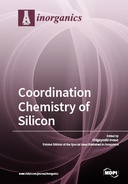Explore

Coordination Chemistry of Silicon
Shigeyoshi Inoue
04.0
0 Ungluers have
Faved this Work
Login to Fave
The chemistry of silicon has always been a field of major concern due to its proximity to carbon on the periodic table. From the molecular chemist’s viewpoint, one of the most interesting differences between carbon and silicon is their divergent coordination behavior. In fact, silicon is prone to form hyper-coordinate organosilicon complexes, and, as conveyed by reports in the literature, highly sophisticated ligand systems are required to furnish low-coordinate organosilicon complexes. Tremendous progress in experimental, as well as computational, techniques has granted synthetic access to a broad range of coordination numbers for silicon, and the scientific endeavor, which was ongoing for decades, was rewarded with landmark discoveries in the field of organosilicon chemistry. Molecular congeners of silicon(0), as well as silicon oxides, were unveiled, and the prominent group 14 metalloid proved its applicability in homogenous catalysis as a supportive ligand or even as a center of catalytic activity. This book focuses on the most recent advances in the coordination chemistry of silicon with transition metals as well as main group elements, including the stabilization of low-valent silicon species through the coordination of electron donor ligands. Therefore, this book is associated with the development of novel synthetic methodologies, structural elucidations, bonding analysis, and also possible applications in catalysis or chemical transformations using related organosilicon compounds.
This book is included in DOAB.
Why read this book? Have your say.
You must be logged in to comment.
Rights Information
Are you the author or publisher of this work? If so, you can claim it as yours by registering as an Unglue.it rights holder.Downloads
This work has been downloaded 200 times via unglue.it ebook links.
- 143 - pdf (CC BY-NC-ND) at Unglue.it.
Keywords
- 2-silylpyrrolidines
- <i>N</i>-heterocyclic carbene
- <i>N</i>-heterocyclic carbenes
- <i>N</i>-heterocyclic carbines
- <i>N</i>-Heterocyclic tetrylene
- <sup>29</sup>Si NMR spectroscopy
- ?-chloro-?-hydrooligosilane
- ?-electron systems
- adsorption
- AIM
- Baird’s rule
- bond activation
- bonding analysis
- bridging silylene ligand
- bromosilylenes
- cluster
- Computation
- computational chemistry
- condensation
- cyclic organopolysilane
- dehydrobromination
- dehydrogenative alkoxylation
- density functional theory
- DFT
- digermacyclobutadiene
- digermene
- disilanylene polymer
- disilene
- disiloxane tetrols
- distorted coordination
- dye-sensitized solar cell
- excited state aromaticity
- functionalization
- germanethione
- Germanium
- germathioacid chloride
- germylene
- host-guest chemistry
- hydrido complex
- hydrogen bonding
- hydrogen bonds
- intermetallic bond
- isocyanide
- isomerization
- ligand-exchange reaction
- main group coordination chemistry
- mechanistic insights
- molecular cage
- molecular orbital analysis
- n/a
- nanoparticle
- organosilicon
- oxidative addition
- Palladium
- photoreaction
- Photostability
- Platinum
- primary silane
- reductant
- ruthenium
- salt-free
- silanetriols
- Silicon
- silicon cluster
- silicon surfaces
- siliconoid
- siloxanes
- silsesquioxanes
- silylene
- silyliumylidenes
- Si–Cl activation
- small molecule activation
- Stereochemistry
- subvalent compounds
- Supramolecular chemistry
- Surface modification
- template
- TiO<sub>2</sub>
- Titanium
- X-ray crystallography
- X-ray diffraction
- α-chloro-ω-hydrooligosilane
- π-electron systems
Links
DOI: 10.3390/books978-3-03897-639-4Editions


